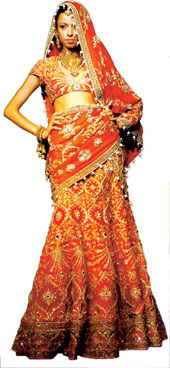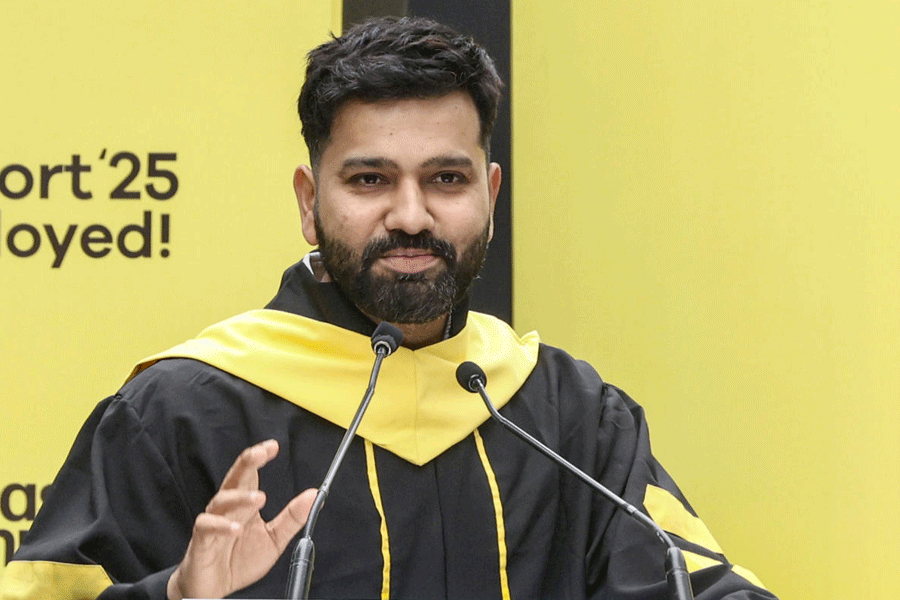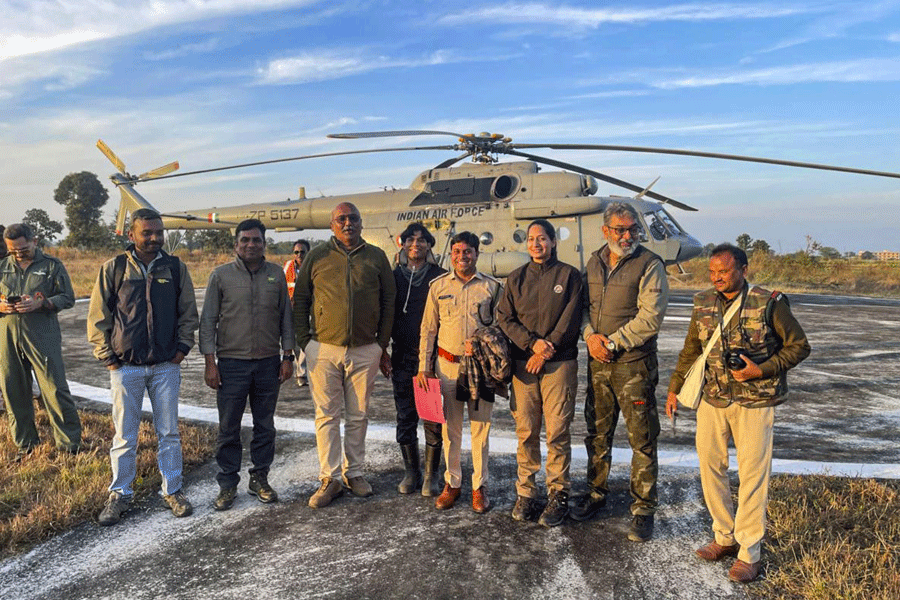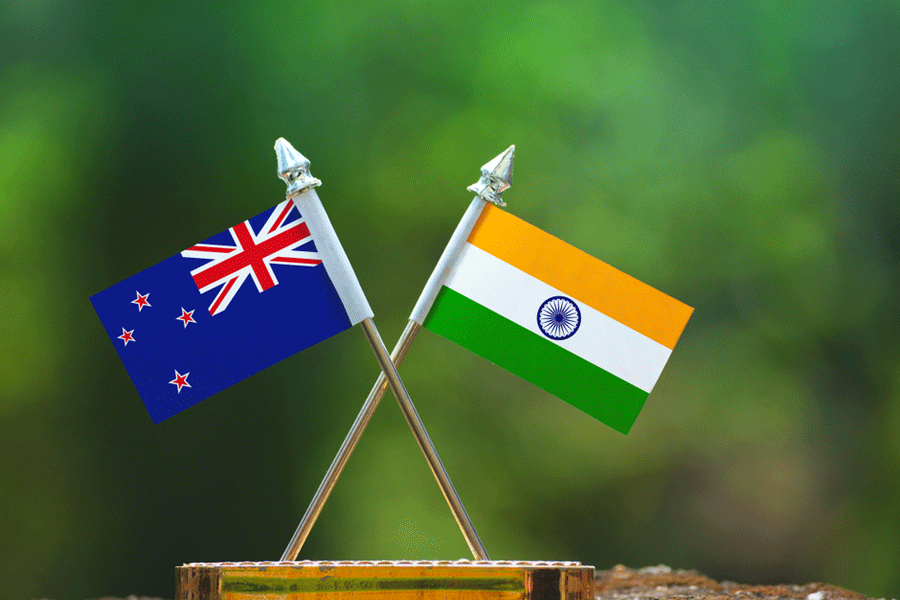 |
 |
 |
 |
| (From top): Sapna Kumar shows off a Mandira Wirk creation; Jesse Randhawa in a Ravi Bajaj sari; the cast and crew of Shararat at the Vie Lounge; a painting by Meera Devidayal |
If Rudyard Kipling said, “East is East and West is West, and never the twain shall meet”, fashion designer Mandira Wirk was all set to prove him wrong at her Fall Winter 2005 collection. “Too Far West is East,” stated the designer who feels that the world is fast moving towards becoming a global city. Wirk’s collection was marked by an interplay of colours, cuts and culture with contemporary styles, fabrics and silhouettes.
The show, held at Delhi’s Hyatt Regency, was high on style with dancing laser beams and dancers in between sequences. Wirk chose to show five lines that evening. The first of these, Innocent Seduction, with its palette of hot pinks, succulent oranges, fresh greens and passionate purples made quite a statement with the message ‘try to resist me’. Next up was Savage Glamour, a line that blended asymmetrical hems with wild floral prints.
This flurry of colour was followed by the Romantic Fable, Vanity Fair and Royal Splendour lines. The Romantic Fable collection concentrated on key colours like blues, purples and coral peaches while pearly white satin creations topped with rosettes marked the Vanity Fair line. The showing concluded with the Royal Splendour range ? a celebration of rich and stately bridal ensembles.
Spotted at the event were actresses Gul Panag and Neena Gupta. Gul who was wearing a Mandira Wirk outfit in pink was all praise for the designer as was model Shefali Talwar.
A classic touch
Five years have passed since Ravi Bajaj has held a show. So naturally it was a much-anticipated affair when the designer showcased his Fall-Winter 2005 collection at an event presented by Moet Hennessey, Danisco and Hyatt Regency in Delhi. Epitomising classic elegance, the collection showcased several lines, beginning with black, the colour that is the couture constant. The three collections of black in the womenswear section began with a line of saris.
The ‘do rukha’ sari has been inspired from a classic Kashmiri embroidery technique. The second series in black was more structured. Jackets in silk and leather, with exaggerated shoulders were teamed with skirts with layered ruching. The fabrics included leather, silk, chiffon and taffeta embellished with roses in leather or with a touch of silver braid.
The final collection in black was inspired by geometrical shapes worn over the dhoti and zip-up or tie-up churidars that offer an ethnic feel, structured for universal appeal.
The colour in the womenswear line was introduced with the sari collection. Inspired by the big cats of the jungle, the tiger motif found its way on to chiffons and georgettes, with beadwork and glinting sequins.
The modern wedding collection in red was elaborate with ornate silver and gold embellishments while the purple palette came in with a collection in wines, plums and mauves that are reminiscent of multi-layered flamenco inspired skirts, worn with corsets. Evening gowns in lime, green and blue incorporated bright colours in multi-layered treatments.
The Ravi Bajaj Menswear Collection showed a line of sharp suits, to which he added a twist by way of colourful pink, orange and red cravats and neck-ties. The Sports Collection celebrated the arrival of winter with tweed, corduroy, leather, wool and denim fabrics. For eveningwear, Bajaj introduced leather sherwanis and dinner jackets and bandhgalas with elegant details.
It’s all in the image
Painter Meera Devidayal says her paintings “almost always begin from an image” and that she turns the “found image into a visual metaphor, which forces the mind out of its rut, and charges it with new meaning”. So when she saw a recurring image of a downcast woman, who seemed to be “every man’s dream wife, waiting for him in a fairytale landscape while he sweats it out in a distant city”, it was her “take-off for an imaginary trip into the mind of a taxi driver”.
The result is an exhibition titled ‘Tum Kab Aaoge...When will you come?’ presented by Gallery Chemould, which opened at Kitab Mahal in Mumbai recently. The predominant image of the taxi is a metaphor, says Devidayal, for migrants who flock from the village to the city with the home on wheels resonating with “memories of family, embellished with messages and prayers, the whole glued together with the magic of fantasy”.
The opening saw a huge gathering. Apart from artists like Bose Krishnamachari, Jehangir Sabavala and Brinda Chudasama, there were also socialites like Dolly Thakore and Nisha Jamval doing the rounds. The exhibition travels to Delhi in October.
No kidding
It was time again for celebrations at UTV TV Content as Shararat completed three years, with a party for the cast and crew at Vie Lounge. UTV’s CEO Ronnie Screwvala and vice-president, television content Monisha Singh presided over the event with Star India’s senior creative director Shaleja Kariwala and executive vice-president Deepak Segal.
Shruti Seth, who plays the lead Jeeya, and Farida Jalal, who plays her great-great-great grandmother, were seen having a great time as were other cast members like Shobha Anand, Mahesh Thakur, Harsh Vashishta and Poonam Narula, who came with husband Manish Goel. Also present were actors from other UTV serials like Samir Soni from Special Squad and Vikas Bhalla from Shanno ki Shaadi. There was the usual cake cutting ceremony and music. Shararat won the Indian Telly Award for best children’s programme last year.
Photographs of Delhi events by Prem Singh










